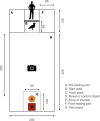Neophobia across social contexts in juvenile herring gulls
- PMID: 40400523
- PMCID: PMC12092120
- DOI: 10.1098/rsos.250398
Neophobia across social contexts in juvenile herring gulls
Abstract
Neophobia, the fear or avoidance of the unfamiliar, can have significant fitness consequences. It is typically assessed by exposing individuals to unfamiliar objects when they are alone, but in social species, the presence of conspecifics can influence neophobia. However, previous research on the effect of group dynamics on neophobic responses has produced mixed results. Here, we explored the degree of neophobia of an individual in different social contexts in a highly social species, the herring gull. To this end, we exposed juvenile herring gulls (n = 54) to novel objects in both individual and group settings (4-5 individuals), replicating each condition twice. Individuals tested in groups were quicker to eat and spent more time near a novel object than individuals tested alone. The results of our study suggest that the presence of group members reduces perceived individual risk, allowing individuals to behave less cautiously. Preregistered Stage 1 protocol: https://osf.io/u4b7q (date of in-principle acceptance: 17 May 2024).
Keywords: animal behaviour; animal personality; behavioural inhibition; herring gull; neophobia; social behaviour.
© 2025 The Author(s).
Conflict of interest statement
We declare we have no competing interests.
Figures




References
-
- Both C, Dingemanse NJ, Drent PJ, Tinbergen JM. 2005. Pairs of extreme avian personalities have highest reproductive success. J. Anim. Ecol. 74, 667–674. ( 10.1111/j.1365-2656.2005.00962.x) - DOI
-
- Greggor AL, Thornton A, Clayton NS. 2015. Neophobia is not only avoidance: improving neophobia tests by combining cognition and ecology. Curr. Opin. Behav. Sci. 6, 82–89. ( 10.1016/j.cobeha.2015.10.007) - DOI
-
- Vrublevska J, Krama T, Rantala MJ, Mierauskas P, Freeberg TM, Krams IA. 2015. Personality and density affect nest defence and nest survival in the great tit. Acta Ethologica 18, 111–120. ( 10.1007/s10211-014-0191-7) - DOI
Associated data
LinkOut - more resources
Full Text Sources

